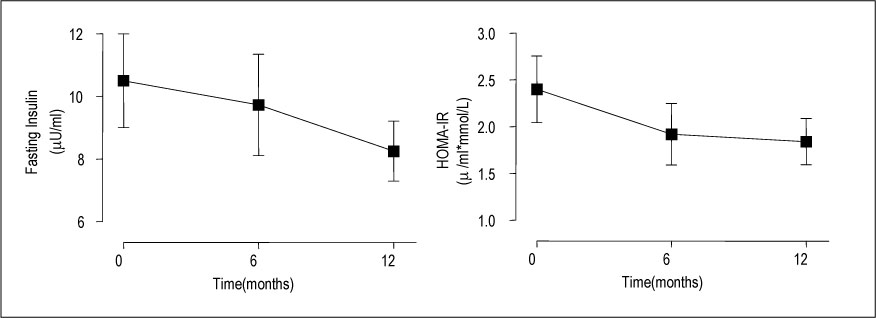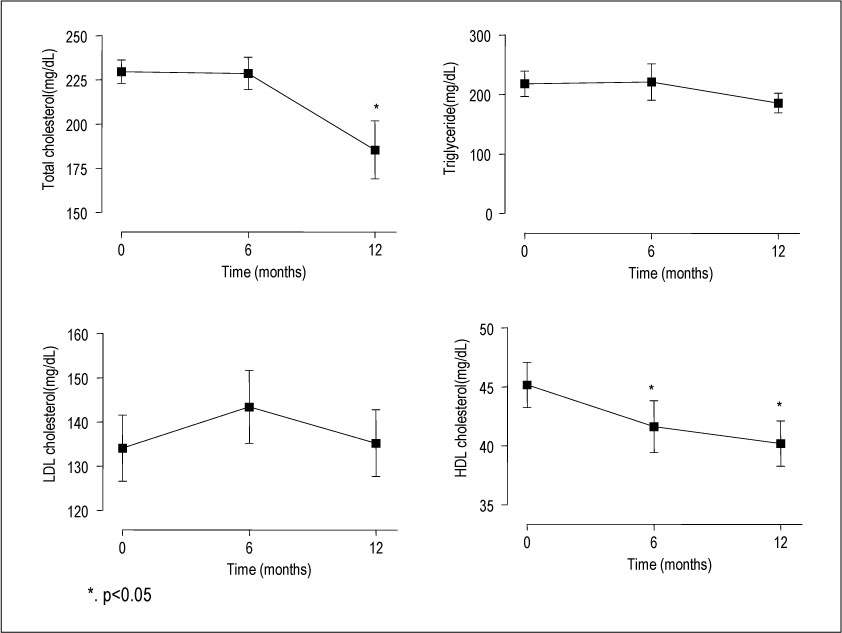J Korean Soc Endocrinol.
2005 Jun;20(3):252-260. 10.3803/jkes.2005.20.3.252.
The Effects on Visceral Fat and Cardiovascular Risk Factors of Testosterone Replacement in Secondary Hypogonadal Men
- Affiliations
-
- 1Department of Internal Medicine, Seoul National University College of Medicine, Seoul, Korea.
- KMID: 2200565
- DOI: http://doi.org/10.3803/jkes.2005.20.3.252
Abstract
-
BACKGROUND: Increased body fat, abdominal obesity and insulin resistance are important clinical features in hypogonadal men. Several studies have demonstrated that a low testosterone concentration in men is associated with coronary heart disease, visceral obesity and insulin resistance. In this study, the effects of testosterone replacement therapy on the abdominal visceral fat and cardiovascular risk factors in hypogonadal men were investigated.
METHODS
We selected 26 men with secondary hypogonadism (mean serum testosterone+/-SD 0.39+/- 0.57ng/mL), who were then treated with testosterone for 12 months. We measured the body composition, including the abdominal visceral fat area by abdominal CT at the L4 level, both before and 12 months after treatment, and the lipid profile, fasting plasma insulin, HOMA-IR and the serum homocysteine, CRP and IL-6 before and 6, 12 months after treatment.
RESULTS
With respect to the body composition, the lean body mass had significantly increased 12 months after treatment(P= 0.002), but there were no significant changes in the body fat mass and abdominal visceral fat area. There was a trend toward a decreased fasting plasma insulin and HOMA-IR, but this did not reach statistical significance. The total cholesterol had decreased significantly at 12 months(P=0.04) and the HDL cholesterol decreased significantly over the course of study(P=0.02). There were no significant changes in the serum homocysteine, CRP and IL-6 after treatment.
CONCLUSIONS
After 12 months testosterone replacement therapy in the 26 men with hypogonadism, the lean body mass had increased significantly, but there was no significant change on the abdominal visceral fat during the treatment period. Testosterone replacement had deleterious effect on HDL cholesterol, but not significant effects on insulin resistance and the serum homocysteine, CRP and IL-6. These results suggest that testosterone replacement therapy may have a few adverse effects on cardiovascular diseases in hypogonadal men. However, it will be necessary to examine the long-term effects of testosterone replacement on the incidence of cardiovascular events as well as the cardiovascular risk factors in men with hypogonadism
MeSH Terms
-
Adipose Tissue
Body Composition
Cardiovascular Diseases
Cholesterol
Cholesterol, HDL
Coronary Disease
Fasting
Homocysteine
Humans
Hypogonadism
Incidence
Insulin
Insulin Resistance
Interleukin-6
Intra-Abdominal Fat*
Male
Multiple Endocrine Neoplasia Type 1
Obesity, Abdominal
Plasma
Risk Factors*
Testosterone*
Tomography, X-Ray Computed
Cholesterol
Cholesterol, HDL
Homocysteine
Insulin
Interleukin-6
Testosterone
Figure
Cited by 1 articles
-
Effects of Androgen on the Cardiovascular System in the Aging Male
Jin Wook Kim, Je Jong Kim, Du Geon Moon
Korean J Androl. 2011;29(1):10-20. doi: 10.5534/kja.2011.29.1.10.
Reference
-
1. Bhasin S, Storer TW, Berman N, et al. A replacement dose of testosterone increases fat-free mass and muscle size in hypogonadal men. J Clin Endocrinol Metab. 1997. 82:407–413.2. Katznelson L, Finkelstein JS, Schoenfeld DA, Rosenthal DI, Anderson EJ, Klibanski A. Increase in bone density and lean body mass during testosterone administration in men with acquired hypogonadism. J Clin Endocrinol Metab. 1996. 81:4358–4365.3. Brodsky JG, Balagopal P, Nair KS. Effects of testosterone replacement on muscle mass and muscle protein synthesis in hypogonadal men-a clinical research center study. J Clin Endocrinol Metab. 1996. 81:3469–3475.4. Snyder PJ, Peachey H, Berlin JA, et al. Effects of testosterone replacement in hypogonadal men. J Clin Endocrinol Metab. 2000. 85:2570–2677.5. Wang C, Swerdloff RS, Iranmanesh A, et al. Transdermal testosterone gel improves sexual function, mood, muscle strength, and body composition parameters in hypogonadal men. Testosterone Gel Study Group. J Clin Endocrinol Metab. 2000. 85:2839–2853.6. Assmann G, Cullen P, Jossa F, Lewis B, Mancini M. Coronary heart disease: reducing the risk. The scientific background to primary and secondary prevention of coronary heart disease. A worldwide view. International Task force for the Prevention of Coronary Heart disease. Arterioscler Thromb Vasc Biol. 1999. 19:1819–1824.7. WU F.C.W, Von Eckardstein A. Androgens and coronary artery disease. Endocr Rev. 2003. 24:183–217.8. Alexandersen P, Christiansen C. The aging male: testosterone deficiency and testosterone replacement. An up-date Atherosclerosis. 2004. 173:157–169.9. Gooren LJG, Bunck MCM. Androgen replacement therapy. present and future. Drugs. 2004. 64:1861–1891.10. Bhasin S, Herbst K. Testosterone and atherosclerosis progression in men. Diabetes Care. 2003. 26:1929–1931.11. Whitsel EA, Boyko EJ, Matsumoto AM, Anawalt BD, Siscovick DS. Intramuscular testosterone esters and plasma lipids in hypogonadal men: a meta-analysis. Am J Med. 2001. 111:261–269.12. Ng MK, Liu PU, Williams AJ, Nakhla S, et al. Prospective study of effect of androgens on serum inflammatory markers in men. Arterioscler Thromb Vasc Biol. 2002. 22:1136–1141.13. Malkin CJ, Pugh PJ, Jones RD, Kappor D, Channer KS, Jones TH. The effect of testosterone replacement on endogenous inflammatory cytokines and lipid profiles in hypogonadal men. J Clin Endocrinol Metab. 2004. 89:3313–3318.14. Giltay EJ, Hoogeveen EK, Elbers JM, Gooren LJ, Asscheman H, Stehouwer CD. Effects of sex steroids on plasma total homocysteine levels: a study in transsexual males and females. J Clin Endocrinol Metab. 1998. 83:550–553.15. Zmuda JM, Bausserman LL, Maceroni D, Thompson PD. The effect of supraphysiologic doses of testosterone on fasting total homocysteine levels in normal men. Atherosclerosis. 1997. 130:199–202.16. Marin P, Holmang S, Jonsson L, et al. The effects of testosterone treatment on body composition and metabolism in middle-aged obese men. Int J Obes Relat Metab Disord. 1992. 16:991–997.17. Marin P, Krotkiewski M, Bjorntorp P. Androgen treatment of middle-aged, obese men: effects on metabolism, muscle and adipose tissues. Eur J Med. 1999. 1:329–336.18. Rebuffe-Scrive M, Marin P, Bjorntorp P. Effect of testosterone on abdominal adipose tissue in men. Int J Obes Relat Metab Disord. 1992. 15:791–795.19. Wajchenberg BL. Subcutaneous and visceral adipose tissue: their relation to the metabolic syndrome. Endocr Rev. 2000. 21:697–738.20. Haffner SM, Valdez RA, Mykkanen L, Laakso M. Insulin resistance, body fat distribution, and sex hormones in men. Diabetes. 1994. 43:212–219.21. Phillips GB. Relationship between serum sex hormones and the glucose-insulin-lipid defect in men with obesity. Metabolism. 1993. 42:116–120.22. Endre bT, Mattiasson I, Berglund G, Hulthen UL. Low testosterone and insulin resistance in hypertension-prone men. J Hum Hypertens. 1996. 10:755–761.23. Defay R, Papoz L, Barny S, Bonnot-Lours S, Caces E, Simon D. Hormonal status and NIDDM in the European and Melanesian populations of New Caledonia: a case-control study. The CALedonia DIAbetes Mellitus(CALDIA) study Group. Int J Obes Relat Metab Disord. 1998. 22:927–934.24. Haffner SM, Shaten J, Stern MP, Smith GD, Kuller L. Low levels of sex hormone-binding globulin and testosterone predict the development of non-insulin-dependent diabetes mellitus in men. MRFIT Research Group. Multiple Risk Factor Interventional Trial. Am J Epidemiol. 1996. 143:889–897.25. Tsai EC, Fujimoto WY, Matsumoto AM, Boyko EJ. Association of bioavailable, free, and total testosterone with insulin resistance. Diabetes Care. 2004. 27:861–868.26. Laaksonen DE, Tuomainen TP, Niskansen L, Valkonen VP, et al. Testosterone and sex hormone-binding globulin predict the metabolic syndrome and diabetes in middle-aged men. Diabetes Care. 2004. 27:1036–1041.27. Seidell JC, Bjorntorp P, Sjostrom L, Kvist H, Sannerstedt R. Visceral fat accumulation men is positively associated with insulin, glucose, and C-peptide levels, but negatively with testosterone levels. Metabolism. 1990. 39:897–901.29. Muller M, Yvonne T, et al. Endogenous sex hormones and cardiovascular disease in men. J Clin Endocrinol Metab. 2003. 88:5076–5086.30. Phillips GB, Pinkernell BII, Jing TY. The association of hypotestosteronemia with coronary artery disease in men. Arterioscler Thromb. 1994. 14:701–706.31. English KM, Mandour O, Steeds RP, Diver MJ, Jones TH, Channer KS. Men with coronary artery disease have lower levels of androgens than men with normal coronary angiograms. Eur Heart J. 1999. 21:890–894.32. Hurley BF, Seals DR, Hagberg JM, et al. High-density-lipoprotein cholesterol in bodybuilders v powerlifters: negative effects of androgen use. JAMA. 1984. 252:507–513.33. Bhasin S, Storer TW, Berman N, et al. The effects of supraphysiologic doses of testosterone on muscle size and strength in normal men. N Engl J Med. 1996. 335:1–7.
- Full Text Links
- Actions
-
Cited
- CITED
-
- Close
- Share
- Similar articles
-
- Testosterone therapy in men with testosterone deficiency: Are we beyond the point of no return?
- Testosterone Deficiency and Nocturia: A Review
- Androgen Receptor Gene CAG Repeat Polymorphism and Effect of Testosterone Therapy in Hypogonadal Men in Korea
- Relationship between Adiponectin, Leptin and Body Fat in Men with Hypogonadism Before and After Testosterone Treatment
- Long Term Cardiovascular Safety of Testosterone Therapy: A Review of the TRAVERSE Study




